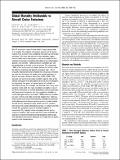Global Mortality Attributable to Aircraft Cruise Emissions
Author(s)
Barrett, Steven R. H.; Britter, Rex E.; Waitz, Ian A.
DownloadBarrett_Global Mortality.pdf (3.475Mb)
PUBLISHER_POLICY
Publisher Policy
Article is made available in accordance with the publisher's policy and may be subject to US copyright law. Please refer to the publisher's site for terms of use.
Terms of use
Metadata
Show full item recordAbstract
Aircraft emissions impact human health though degradation of air quality. The majority of previous analyses of air quality impacts from aviation have considered only landing and takeoff emissions. We show that aircraft cruise emissions impact human health over a hemispheric scale and provide the first estimate of premature mortalities attributable to aircraft emissions globally. We estimate ~8000 premature mortalities per year are attributable to aircraft cruise emissions. This represents ~80% of the total impact of aviation (where the total includes the effects of landing and takeoff emissions), and ~1% of air quality-related premature mortalities from all sources. However, we note that the impact of landing and takeoff emissions is likely to be under-resolved. Secondary H[subscript 2]SO[subscript 4]−HNO[subscript 3]−NH[subscript 3] aerosols are found to dominate mortality impacts. Due to the altitude and region of the atmosphere at which aircraft emissions are deposited, the extent of transboundary air pollution is particularly strong. For example, we describe how strong zonal westerly winds aloft, the mean meridional circulation around 30−60°N, interaction of aircraft-attributable aerosol precursors with background ammonia, and high population densities in combination give rise to an estimated ~3500 premature mortalities per year in China and India combined, despite their relatively small current share of aircraft emissions. Subsidence of aviation-attributable aerosol and aerosol precursors occurs predominantly around the dry subtropical ridge, which results in reduced wet removal of aviation-attributable aerosol. It is also found that aircraft NO[subscript x] emissions serve to increase oxidation of nonaviation SO[subscript 2], thereby further increasing the air quality impacts of aviation. We recommend that cruise emissions be explicitly considered in the development of policies, technologies and operational procedures designed to mitigate the air quality impacts of air transportation.
Date issued
2010-10Department
Massachusetts Institute of Technology. Department of Aeronautics and Astronautics; Massachusetts Institute of Technology. Department of Urban Studies and Planning; Massachusetts Institute of Technology. School of EngineeringJournal
Environmental Science & Technology
Publisher
American Chemical Society (ACS)
Citation
Barrett, Steven R. H., Rex E. Britter, and Ian A. Waitz. “Global Mortality Attributable to Aircraft Cruise Emissions.” Environmental Science & Technology 44, no. 19 (October 2010): 7736-7742. © 2010 American Chemical Society
Version: Final published version
ISSN
0013-936X
1520-5851